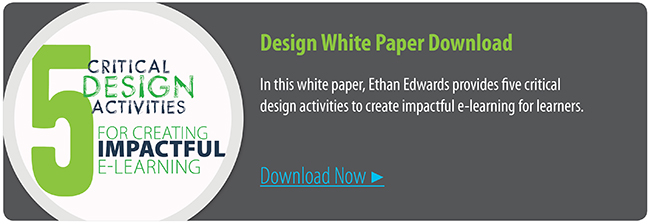ATD Blog
Five Critical Design Activities for Creating Impactful E-Learning
Mon Aug 26 2013

I presented a webinar for ASTD on August 5, 2013: “Five Critical Design Activities for Creating Impactful E-Learning.” One never knows when starting out to make a presentation whether it is a significant message. As it turned out, the response to this talk was really gratifying and in the course of delivering this message, I realized even more forcefully that these ideas are instrumental in creating e-learning that makes the unique promise of computers to facilitate learning. The five perspectives covered in the webinar are listed here to emphasize their importance.
It isn’t quite true that these are five activities, but they are rather five convictions, and when used, they can guide one’s actions to produce award-winning custom courses.
The five activities:
1. Don’t rely on storyboards.
In particular, don’t rely on storyboards for design. If your organization requires storyboards for documentation or legal sign-off, then perhaps you should use them for that. In general, storyboards are a horrible tool to foster creativity and interactivity. They force linear thinking, focus initial effort on the wrong lesson components, require too much work without the benefit of useful feedback, drive too much attention on strictly delivering content, and generally result in boring e-learning.
2. Test your interactivity with sketches and prototypes.
Sketches and prototypes are tentative; they might represent a solution or they might be a dead end. This approach of trial and adjustment is critical for working your way to a great solution. No one’s first idea is always the best. Approach the design process with open creativity, honestly testing and adjusting prototypes before both ego and resource investment in an untested solution create certain failure.
3. Don’t work linearly.
In most designs, the very beginning is neither the most interesting nor the most important part of the lesson. Yet that is where many designers spend a disproportionately large part of their time—mainly because storyboards lead people in that direction. Don’t do it. Instead, start at the end: on the most important outcome, the most difficult objective, the most memorable actions. These are the parts that need your greatest effort. The early stuff will fall into place easily if you get these ultimate interactions right.
4. Pretend your learners can’t read.
Now most of your readers actually can read—but many choose not to read, especially in e-learning. So if many learners are not reading much of what you are carefully crafting for them, your writing won’t make any difference. Instead, think about how you could show this content in a way that would draw the learner’s attention voluntarily. It is unlikely to be another paragraph of text. It is much more likely to be a visual simulated environment (either real or artificial) that draws the learner in through interest, emotion, or immediate relevance that can be used to improve the learner’s ability to read for meaning.
5. Seek input from others—as early as possible.
It is impossible to be an objective judge of your own design without some feedback and assessment from someone else. Of course you tend to think your designs are good; otherwise you wouldn’t have come up with them. You need honest feedback of your design before you start investing in all the time necessary to create the lesson. Most project testing (alpha tests, beta tests, and so on) turn more into validating the development and implementation rather than any sort of validation of the underlying design. So to improve the potential of your designs, be aggressive in assuring that you will get someone else’s eyes and attention during the design activities in your development process.
I hope these seem as powerful to you as I am certain they are. If you adopt these viewpoints and adjust your design focus accordingly, you will find confidence in using the Successive Approximation Model (SAM)to design and pleasure in creating instructional interactivity that is completely memorable and empowering to the learners.
You've Reached ATD Member-only Content
Become an ATD member to continue
Already a member?Sign In
